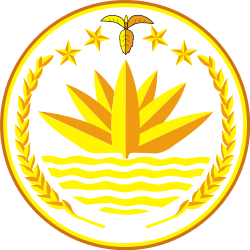Government of Bangladesh
 |
| This article is part of a series on the politics and government of Bangladesh |
|
Constitution |
|
Executive |
|
|
Political parties |
|
Foreign policy |
The Government of Bangladesh (Bengali: বাংলাদেশ সরকার Bangladesh Sôrkar GOB) is led by the Prime Minister, who selects all the remaining Ministers. The Prime Minister and the other most senior Ministers belong to the supreme decision-making committee, known as the Cabinet.
The current Prime Minister is Sheikh Hasina, leader of the Bangladesh Awami League, who was appointed by the President on 6 January 2009 following the General Election on 29 December 2008. Bangladesh Awami League led by her, and its Grand Alliance (a total of 14 parties) won the two-thirds majority numerically the party controls 230 seats out of 299.[1]
Executive branch
| Office | Name | Party | Since |
|---|---|---|---|
| President of Bangladesh | Abdul Hamid | Awami League | 24 March 2013 |
| Prime Minister of Bangladesh | Sheikh Hasina | Awami League | 6 January 2009 |
The President is the head of state, a largely ceremonial post. The real power is held by the Prime Minister, who is the head of government. The president is elected by the legislature every five years and has normally limited powers that are substantially expanded during the tenure of a caretaker government, mainly in controlling the transition to a new government. Bangladesh has instituted a unique system of transfer of power; at the end of the tenure of the government, power is handed over to members of a civil society for three months, who run the general elections and transfer the power to elected representatives. This system was first practiced in 1991 and adopted to the constitution in 1996.[2]
The prime minister is ceremonially appointed by the president, commanding the confidence of the majority of the MPs. The cabinet is composed of ministers selected by the prime minister and appointed by the president.
Legislative branch
.jpg)
The legislature of Bangladesh is unicameral. The 300 members are elected by universal suffrage at least every 5 years. It consists of 350 members at present. There is universal suffrage for all citizens at the age of 18.
"On 16 May 2004, the Jatiyo Sangsad (the National Parliament) passed the 14th constitutional amendment to reintroduce quotas for women (article 65). The number of seats in parliament is to be raised to 345, 45 (15%) of which will be reserved for women in the next parliament. The seats will be allocated to parties in proportion to their overall share of the vote. This quota system replaces the previous quota law which expired in 2001. Until 2001 a system of reserved seats for women was used, where 30 seats out of 330 were reserved to women (chosen by indirect election by the 300 directly elected MPs). This provision of guaranteeing women reserved seats expired in April 2001. This quota system was first introduced by the 1972 Constitution (originally providing for 15 reserved seats for women, out of 315 seats, for a period of 10 years). In 1978 a presidential proclamation enlarged the number of reserved seats to 30 and extended the period of reservation to 15 years from the date of promulgation of the constitution of the Republic in December 1972. The constitutional provision lapsed in 1987 and was re-incorporated in the constitution by an amendment in 1990 to be effective for 10 years from the first meeting of the legislature next elected. This provision also lapsed in 2001. The Parliament elected in October 2001 does not have reserved seats for women. Women's groups are lobbying for these seats to become directly elected positions and for the number of reserved seats to be increased."
The 10th Parliament had its first sitting on January 25, 2009 . Currently there are 350 members of the house of which 50 memberships are reserved for women.[3]
Executive Administration
The executive administrates the country and executes the laws, passed by the legislature. It maintains the internal law and order in the country. It also maintains relationship with foreign countries. It works for defense, liberty and sovereignty of the country.
As head of the state, the president can grant pardon to a man sentenced to death penalty or lessen the punishment. In some cases, it also performs some legislative and judicial functions. The executive on the other hand calculated the income and expenditure of the government. It also performs various public welfare services such as; education, agriculture, establishment of industry, trade & commerce, land reform, tax and revenue collection. Beside this, it also accepts and implements various development projects.
Judicial branch
The highest judiciary body is the Supreme Court. Until recently, Chief Justice and judges were recommended by the Prime Minister and formally appointed by the President. Since 1991, political parties during their tenure in government have initiated the separation of the judiciary from control by the executive branch brought about by amendment of the Constitution of Bangladesh in 1975. The separation by presidential promulgation acts have signed and passed. Acts on the separation of Judiciary Administration, Remuneration, Pay and Leave, etc. have all been completed. The Supreme Court have now judiciary and administrative authority over all lower courts in the country.
Administrative divisions
At the local government level, the country is divided into divisions, districts, subdistricts (Upazila), unions, and villages. The lowest level of local government representative are Local officials of union council those who are elected at the union level election. All larger administrative units are run by members of the civil service.
See also
References
- ↑ "Hasina wins Bangladesh landslide", BBC
- ↑ 14th Amendment, Constitution of Bangladesh, 1996.
- ↑ Bangladesh and Global Studies (NCTB)
